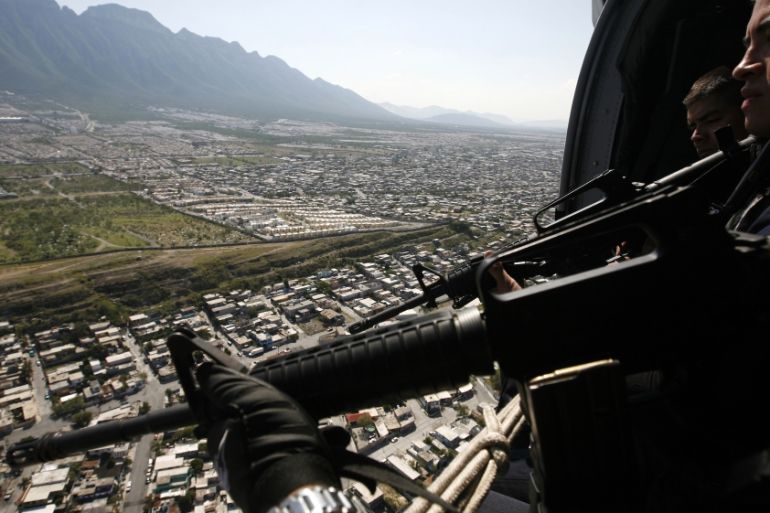Is Mexico the most dangerous country on earth?
Or does it just suffer from the misfortune of being a neighbour of the US?

In 2006, Mexico launched a war on drugs with the fervent backing of its ever-helpful neighbour to the north, the United States of America.
Now a bit more than a decade later, some 200,000 people are estimated to have been killed thus far as a result, with an additional 30,000 or more disappeared and a continuous discovery of unmarked mass graves.
Keep reading
list of 4 itemsWest Africa’s Sahel becoming a drug trafficking corridor, UN warns
Behind India’s Manipur conflict: A tale of drugs, armed groups and politics
Why are some countries decriminalising drugs?
Recent reports suggest that 2017 was, in fact, Mexico’s most violent year, in terms of homicides, since the Mexican government began publicising crime data in 1997. More than 29,000 murders were recorded last year alone.
And what do you know: Drugs continue to flow into the US, where the proscription of mind-altering substances that are in sky-high demand is precisely what has rendered the drug business in Mexico so lethally lucrative in the first place.
Perverse symbiosis
Arturo Cano, a journalist with the prominent Mexican newspaper La Jornada, once commented to me on the perverse symbiosis that has long characterised the US-Mexico relationship: “Mexico provides the cheap labour and the US provides the deportees. Mexico provides the dead and disappeared and the US the armies of drug users”.
Cano went on to invoke a lament attributed to former Mexican dictator Porfirio Diaz, who died in 1915: “Poor Mexico, so far from God, so close to the United States”.
Indeed, thanks to acute geographical misfortune, Mexico has been an easy target for economic abuse by its northern neighbour – entailing magical forms of “free trade” in which the US is permitted to freely bombard the Mexican market with subsidised products while driving several million Mexican farmers out of business.
Unsurprisingly, destroying a whole lot of livelihoods is not the best way to deter people from pursuing options more conducive to financial survival – including, as it turns out, in the field of narco-activity.
Meanwhile, the US handily offsets its considerable contributions to the forging of the Mexican narco-state by donating billions of dollars to the drug war effort.
This arrangement effectively amounts to throwing more money into a landscape of impunity in which notoriously corrupt security forces are implicated in extrajudicial massacres and deadly collaboration with drug cartels.
Not that a country where police regularly kill unarmed black people should be regarded as the standard bearer for ethical behaviour.
Perpetuating war
Amnesty International has noted that, as a result of Mexico’s drug war, reports of torture and other ill-treatment by Mexican police and military officials grew by 600 percent between 2003 and 2013.
And according to a 2016 Amnesty International document, Mexican security forces “routinely torture and ill-treat women” who they detain in group arrests in order to “to boost figures and show society that the government’s security efforts are yielding results”.
When it comes to keeping the old casus belli alive, the US Drug Enforcement Administration (DEA) is in the very same boat on the other side of the border; after all, if you actually win a war on drugs, there’ll be no more incoming funds to fight that war forever and ever.
As Carmen Boullosa and Mike Wallace observe in their book A Narco History: How the United States and Mexico Jointly Created the ‘Mexican Drug War’, the DEA would “be hard-pressed to justify its annual budget of roughly $2.5bn if the legal ground shifted beneath it” towards drug decriminalisation.
In 2006, as Ginger Thompson ably narrates in a New Yorker piece titled “Trafficking in Terror”, the DEA hoisted itself onto the ever-profitable war on terror bandwagon with the help of the scary new crime of “narco-terrorism”.
But just as the US is unqualified to fight a literal war on terror – engaging as it does in regular bouts of terror-inducing activity across the globe – the country’s drug war credentials are somewhat less than impeccable, particularly when one considers New York Times headlines like “The CIA Drug Connection Is as Old as the Agency“.
Dangers galore
It would require a document longer than Donald Trump’s fetishised border wall to adequately delve into the US’ history of complicity in the international drug trade – from Vietnam to Pakistan to Panama and Honduras.
In one especially memorable episode in the 1980s, an endearing US partnership with right-wing Nicaraguan Contras led to a certain crack cocaine epidemic in the US and the devastation of black communities in South Central Los Angeles.
In more recent years, US shamelessness has included cooperation between the DEA and none other than Mexico’s Sinaloa cartel.
Enter current US president and disseminator extraordinaire of fake news, who tweeted on January 18 with regard to his proposed border monstrosity: “We need the Wall to help stop the massive inflow of drugs from Mexico, now rated the number one most dangerous country in the world”.
Never mind that Mexico’s homicide rate is in fact lower than that of other regional US buddies – and preferred “drug war” partners – like Colombia.
In any case, Trumpian reality has now officially awarded the position of “number one most dangerous country in the world” to a place long victimised by the US – the very same US that, in cultivating a disproportionately trigger-happy culture at home, could very well stand to issue travel advisories for its own domestic classrooms, nightclubs, and playgrounds.
Add to these truths the US habit of invading and traumatising other countries at will, and the country itself might – just might – start to seem like the most dangerous one on earth.
The views expressed in this article are the author’s own and do not necessarily reflect Al Jazeera’s editorial stance.
